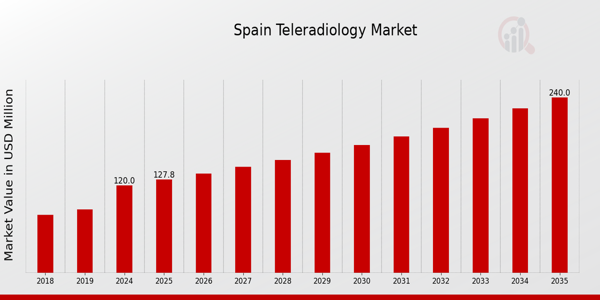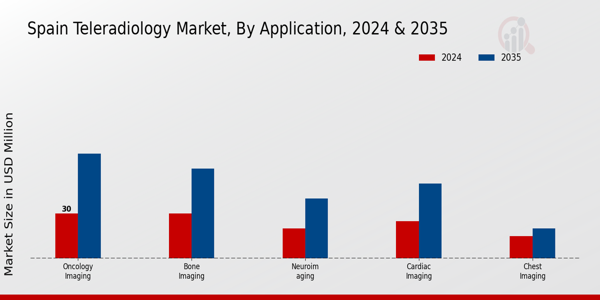Spain Teleradiology Market Overview
As per MRFR analysis, the Spain Teleradiology Market Size was estimated at 112.75 (USD Million) in 2023. The Spain Teleradiology Market Industry is expected to grow from 120(USD Million) in 2024 to 240 (USD Million) by 2035. The Spain Teleradiology Market CAGR (growth rate) is expected to be around 6.504% during the forecast period (2025 - 2035)
Key Spain Teleradiology Market Trends Highlighted
The Spain Teleradiology Market is experiencing significant growth driven by several key market drivers. One of the most influential factors is the increasing demand for remote diagnostics, particularly in rural areas where access to specialized medical professionals is limited.
This demand is supported by the Spanish government's initiatives to enhance healthcare accessibility and digital health integration, highlighting the importance of innovative telehealth solutions. Furthermore, the ongoing advancements in technology, such as improved internet connectivity and high-definition imaging, are facilitating the wider adoption of teleradiology services across Spain.Opportunities in Spain’s teleradiology sector are also becoming more apparent.
The aging population is leading to a rise in chronic diseases, resulting in a greater need for efficient diagnostic services. Healthcare facilities are therefore looking to expand their teleradiology capabilities to manage patient volumes more effectively. Additionally, partnerships between healthcare providers and technology firms are emerging, fostering the development of new solutions that can further enhance remote consulting services.
Recent trends indicate a notable shift towards integrating artificial intelligence in teleradiology, streamlining the analysis of imaging results, and improving accuracy in diagnoses.This evolution aligns with Spain's efforts to foster innovation in healthcare technologies. Moreover, the COVID-19 pandemic accelerated the adoption of telehealth services, paving the way for more permanent changes in how radiology services are provided.
As these trends continue to unfold, Spain's teleradiology market stands to benefit significantly, positioning itself as a vital component in the country's healthcare system.

Source: Primary Research, Secondary Research, Market Research Future Database and Analyst Review
Spain Teleradiology Market Drivers
Increase in Chronic Diseases
One of the main factors propelling the Spain Teleradiology Market Industry is the increase in chronic illnesses like cancer and cardiovascular diseases. The Ministry of Health of the Spanish Government reports that over 24% of the population has a chronic condition, and that the number of cancer cases is rising, which is driving up demand for diagnostic imaging services.
According to the Spanish Society of Medical Oncology, the number of new cancer cases in Spain is rising by 6.7% every year. As medical institutions work to enhance patient care and expedite diagnosis procedures, teleradiology services are becoming more and more necessary due to the rising incidence of certain disorders. This ensures that treatment may begin sooner. To meet these growing healthcare demands, major players in this industry, including Telefnica, have made significant investments in digital health services, including teleradiology.
Technological Advancements
The integration of advanced imaging technologies such as Artificial Intelligence (AI) and Machine Learning (ML) in teleradiology platforms is propelling the growth of the Spain Teleradiology Market Industry. The Spanish government encourages technological innovation through various funding programs, which have resulted in companies like Radiology Partners developing sophisticated imaging solutions.
These advancements enhance the accuracy and efficiency of radiological interpretations, thus improving patient outcomes significantly.The Teleradiology Services Association of Spain indicates that adopting AI-driven solutions can increase interpretation accuracy by up to 30%, rendering more timely diagnoses across healthcare facilities in Spain.
Growth of Remote Healthcare Services
The surge in remote healthcare services propelled by the COVID-19 pandemic has positively influenced the Spain Teleradiology Market Industry. The Spanish healthcare system adapted swiftly to incorporate telemedicine, leading to a higher demand for remote diagnostic services.
According to the Spanish Health Ministry, telemedicine usage increased by 70% in 2020, during the height of the pandemic, allowing diagnostic imaging to be conducted remotely.Healthcare providers, such as Quirnsalud, have expanded their teleradiology services to cater to this rising trend, which facilitates remote consultations and reduces waiting times for patients.
Regulatory Support for Digital Health
The Spanish Government has enacted supportive regulatory frameworks aimed at promoting digital health innovations, including teleradiology. Recent legislation under the Digital Health Strategy of Spain emphasizes the importance of integrating digital solutions in medical practices, which aids in streamlining healthcare delivery. The government aims to provide greater access to health services, especially in rural areas where traditional radiology services are limited.This regulatory environment encourages companies, such as Siemens Healthineers, to invest in the teleradiology sector, as they can now operate within a clear and supportive legal framework, ultimately pushing the Spain Teleradiology Market Industry towards sustainable growth.
Spain Teleradiology Market Segment Insights
Teleradiology Market Application Insights
The Application segment of the Spain Teleradiology Market plays a crucial role in transforming the healthcare delivery system through improved imaging techniques that facilitate remote diagnoses. Spain's growing digital health landscape underscores the increasing prevalence of teleradiology, a trend largely driven by the rising demand for prompt and accurate imaging services. Among the various applications, Bone Imaging stands out due to its extensive utilization in detecting fractures, degenerative diseases, and infections, which significantly impact patient management and treatment plans.
Cardiac Imaging, another vital application, is pivotal in diagnosing heart conditions, allowing for early intervention and effective patient care, thereby contributing to the reduction of cardiovascular-related mortality rates in the country. Neuroimaging is particularly critical in Spain, especially in urban settings, where there is a growing population of patients suffering from neurological disorders; its ability to provide real-time insights into brain health becomes increasingly integral in managing conditions such as stroke, tumors, and degenerative diseases.Oncology Imaging is equally significant, as it enables the precise localization of tumors, thereby assisting oncologists in personalizing treatment strategies and monitoring treatment response.
Furthermore, Chest Imaging serves a dual purpose in diagnosing both respiratory ailments and identifying complications associated with COVID-19, thus showcasing its increased relevance in the current healthcare climate. The demand across all these applications is propelled by factors such as technological innovations, the need for cost-effective healthcare solutions, and an increase in chronic diseases, with the Spain Teleradiology Market showing promising growth potential.
The integration of artificial intelligence within these applications further enhances diagnostic accuracy and streamlines workflow, thereby addressing significant challenges faced in traditional radiology practices. Overall, as the healthcare sector in Spain continues to advance, the Application segment of teleradiology remains a foundational pillar, enhancing the quality and accessibility of medical imaging services across the nation.

Source: Primary Research, Secondary Research, Market Research Future Database and Analyst Review
Teleradiology Market Modality Insights
The Modality segment within the Spain Teleradiology Market is a crucial area reflecting the expanding capabilities of remote diagnostic imaging. This segment encompasses various technologies, including X-Ray, CT Scan, MRI, Ultrasound, and Nuclear Medicine, each contributing uniquely to healthcare delivery. X-Ray technology remains significant due to its widespread application in diagnosing fractures and infections, while CT Scans offer detailed imaging crucial for trauma assessment and cancer detection, making it a vital tool in emergency care.
MRI stands out for its exceptional ability to visualize soft tissues, playing an essential role in neurology and oncology.Ultrasound is favored for its safety, cost-effectiveness, and real-time imaging, often used in obstetrics and cardiac evaluations, enhancing prenatal care and overall patient monitoring. Nuclear Medicine, although less prevalent, is indispensable for functional imaging and therapy, particularly in oncology and cardiology. The increasing prevalence of chronic diseases in Spain drives demand across these modalities, underpinned by technological advancements and the growing trend towards patient-centered care.
Collectively, this segment's innovations and its integration into teleradiology enhance accessibility and diagnostic accuracy, leading to improved patient outcomes across the healthcare continuum in Spain.
Teleradiology Market End Use Insights
The End Use segment of the Spain Teleradiology Market plays a crucial role in advancing healthcare delivery across the country. Hospitals continue to be a dominant force, leveraging teleradiology services to enhance efficiency and provide timely diagnostics, particularly in rural and underserved areas. Diagnostic Imaging Centers are also significant, facilitating quick transmission of imaging data, thus expediting decision-making processes and improving patient outcomes. Research Organizations benefit from teleradiology as it allows for the centralization of data and collaboration among various institutions, fostering innovation and enhancing research capabilities.
Home Healthcare is gaining traction as more patients prefer receiving care in familiar environments, benefiting from remote consultations and monitoring. Emergency Care harnesses teleradiology to ensure immediate access to radiological expertise, which is vital in critical situations. Overall, the diverse applications of teleradiology across these various end-use segments underscore its importance in shaping a more integrated and responsive healthcare system in Spain. As the healthcare landscape continues to evolve, these segments are poised for growth, driven by technological advancements and an increasing demand for remote medical services.
Teleradiology Market Configuration Insights
The Configuration segment within the Spain Teleradiology Market is a critical area that is witnessing significant growth due to the increasing demand for efficient and accessible medical imaging services. The Spanish healthcare system has been increasingly adopting advanced technologies to enhance patient care, which thus impacts the Configuration segment positively. Given the robust infrastructure, cloud-based solutions are gaining traction due to their flexibility, scalability, and cost-effectiveness, facilitating remote access to patient data and images.Web-based solutions also play a pivotal role, allowing healthcare professionals to connect seamlessly across various platforms, thus improving diagnostic accuracy and collaboration.
Furthermore, standalone systems continue to hold importance in specific niche markets with rigid operational requirements. Overall, the diversity in Configuration types caters to different needs within the healthcare ecosystem in Spain, reinforcing efficiency in service delivery while addressing the unique challenges posed by traditional radiology practices. As the industry continues to evolve, these configurations are integral in driving the innovation necessary to improve patient outcomes and enhance the overall functioning of the healthcare system within Spain.
Spain Teleradiology Market Key Players and Competitive Insights
The competitive landscape of the Spain Teleradiology Market has witnessed significant developments fueled by the increasing demand for remote diagnostic services and advancements in healthcare technology. The market comprises various players, each striving to enhance their service offerings and establish a strong foothold. Teleradiology, which allows for the transmission of radiological images over electronic networks, has become particularly relevant in Spain as healthcare providers look to improve efficiency, reduce wait times, and enhance patient access to radiological services.
The competition is characterized by the adoption of innovative solutions, partnerships with healthcare facilities, and a focus on integrating artificial intelligence to optimize imaging processes.
As the market evolves, providers are also concentrating on complying with regulatory standards and addressing patient privacy concerns, thus driving the competitive dynamics further.Rays has established a substantial presence in the Spain Teleradiology Market by leveraging cutting-edge technology and strong partnerships with medical institutions. The company's strengths lie in its comprehensive range of teleradiology services, focusing on high-quality imaging and rapid turnaround times. Rays is recognized for its ability to efficiently manage a large volume of radiological studies and provide timely reports to healthcare providers, which enhances decision-making in patient care.
The company's commitment to technological excellence has positioned it favorably in the market, as it continuously invests in state-of-the-art imaging software and robust data management systems. Additionally, Rays emphasizes exceptional customer service and engagement with radiologists, ensuring a collaborative approach to patient diagnostics that benefits both healthcare providers and patients across Spain.Siemens Healthineers is a key player in the Spain Teleradiology Market, renowned for its innovative medical technology solutions and advanced imaging systems.
The company's product portfolio includes a variety of imaging modalities such as MRI, CT, and ultrasound, all of which are integral to its teleradiology offerings. Siemens Healthineers has opted for a strategic approach that emphasizes partnerships and collaborations with healthcare networks, aiming to facilitate seamless integration of teleradiology services into existing workflows. Their strengths are highlighted by a strong market position, extensive experience in medical technology, and a commitment to research and development. This company has also engaged in mergers and acquisitions to broaden its capabilities and reach within the Spanish market.
Through its focus on innovation and customer-centric services, Siemens Healthineers has established itself as a trusted leader, providing the necessary tools for healthcare professionals to effectively leverage teleradiology in enhancing patient care in Spain.
Key Companies in the Spain Teleradiology Market Include
- Fujifilm Holdings Corporation
Spain Teleradiology Market Industry Developments
Recent developments in the Spain Teleradiology Market have been notable, particularly with advancements from major companies such as Philips Healthcare and Siemens Healthineers, focusing on enhancing telemedicine solutions and radiology technology. The market continues to evolve, particularly during the COVID-19 pandemic, which accelerated the adoption of remote diagnostic services. In May 2023, GE Healthcare announced a partnership with Spanish hospitals to enhance data analytics in teleradiology, bolstering efficiency and accuracy in diagnostic services. Additionally, in a significant merger, Radiology Partners acquired a notable teleradiology practice in Spain in April 2023, enhancing its presence in the European market.
This acquisition is expected to further integrate advanced teleradiology services across various healthcare facilities in Spain. The market valuation is growing due to an increased need for accessible diagnostic imaging and improved healthcare outcomes. Companies like Fujifilm Holdings Corporation and AgfaGevaert Group are also significantly investing in research and development for innovative solutions. The Spanish government has been supportive of digital health initiatives, which further fuels market growth and adaptation to current healthcare demands. Overall, these developments reflect the expanding potential of the teleradiology sector in Spain.
Spain Teleradiology Market Segmentation Insights
-
Teleradiology Market Application Outlook
-
Teleradiology Market Modality Outlook
-
Teleradiology Market End Use Outlook
- Diagnostic Imaging Centers
-
Teleradiology Market Configuration Outlook
| Report Attribute/Metric Source: |
Details |
| MARKET SIZE 2023 |
112.75(USD Million) |
| MARKET SIZE 2024 |
120.0(USD Million) |
| MARKET SIZE 2035 |
240.0(USD Million) |
| COMPOUND ANNUAL GROWTH RATE (CAGR) |
6.504% (2025 - 2035) |
| REPORT COVERAGE |
Revenue Forecast, Competitive Landscape, Growth Factors, and Trends |
| BASE YEAR |
2024 |
| MARKET FORECAST PERIOD |
2025 - 2035 |
| HISTORICAL DATA |
2019 - 2024 |
| MARKET FORECAST UNITS |
USD Million |
| KEY COMPANIES PROFILED |
Rays, Siemens Healthineers, VNA Healthcare, Philips Healthcare, Onrad, Fujifilm Holdings Corporation, GE Healthcare, Nighthawk Radiology, AgfaGevaert Group, Radiology Partners, Mednax, eRadiology, Teleradiology Solutions, Teladoc Health |
| SEGMENTS COVERED |
Application, Modality, End Use, Configuration |
| KEY MARKET OPPORTUNITIES |
Growing telehealth adoption, Increasing demand for radiology services, Need for remote diagnostics, Cost reduction in healthcare, Technological advancements in imaging |
| KEY MARKET DYNAMICS |
increasing demand for remote diagnostics, rising healthcare IT adoption, shortage of radiologists, cost-effectiveness of teleradiology services, technological advancements in imaging techniques |
| COUNTRIES COVERED |
Spain |
Frequently Asked Questions (FAQ):
The Spain Teleradiology Market is projected to be valued at 120.0 million USD in 2024.
By 2035, the Spain Teleradiology Market is expected to reach a valuation of 240.0 million USD.
The expected CAGR for the Spain Teleradiology Market from 2025 to 2035 is 6.504%.
The market value of Bone Imaging in 2024 is 30.0 million USD.
The market value of Cardiac Imaging is expected to reach 50.0 million USD by 2035.
Major players in the market include Rays, Siemens Healthineers, Philips Healthcare, and GE Healthcare.
The market value of Oncology Imaging is expected to be 70.0 million USD by 2035.
In 2024, Neuroimaging is projected to have a market value of 20.0 million USD.
The expected market size for Chest Imaging by 2035 is 20.0 million USD.
The growth of the Spain Teleradiology Market is driven by advancements in imaging technology and increasing demand for remote diagnostics.
















